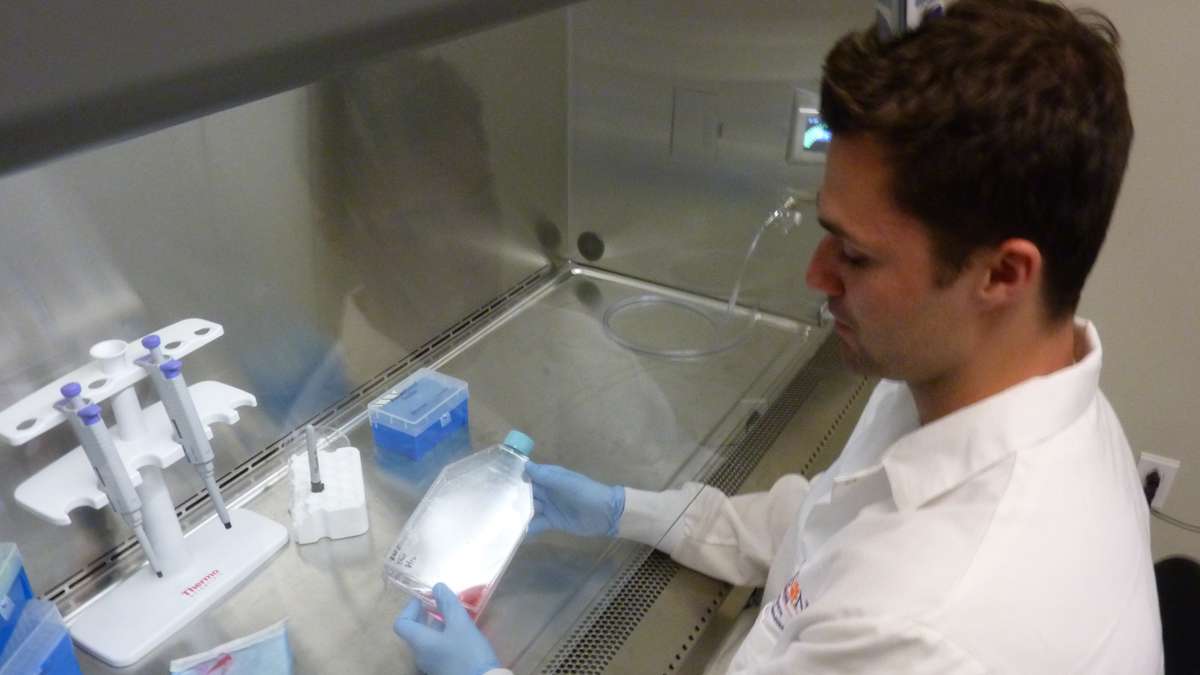A 3D printer that squirts out the building blocks of life
ListenBioBots, a Philly biotech startup, gears up for growth.
Complete with big windows, a high-rise view and shiny lab space, the staff of BioBots is having no trouble adjusting to the company’s new digs at the Science Center in West Philadelphia.
“We just moved in here about a month ago, so as you can see, we are just getting set up,” says Danny Cabrera, co-founder of the one-year-old biotech startup.
The company is settling in just in time for the launch of its newly redesigned 3D printer, which will be unveiled next month at a major industry event in Boston. The machine, like the first version BioBot, prints out living tissue in intricate patterns, mimicking the complex environment where cells inside the human body exist and thrive.
Traditional 3D printers, of course, don’t use the building blocks of life as a raw ingredient. Most devices turn spools of plastic, metal or wood filament into pre-programmed shapes (bracelets, guitars, sometimes guns) by heating the material and then hardening it into a finished product. But that method doesn’t work with bioprinting.
“You definitely cannot use heat with living cells,” says Cabrera. “You would burn and fry everything.”
Another 3D printing method, which involves UV radiation, also wouldn’t work, because of the harm he says it would cause to the DNA. BioBots solves this problem by using a series of LED lights to harden the materials into a desired shape as it exits the tip of a syringe.
What comes out aren’t just cells alone, however. They get mixed into a substance called bio-ink, which serves as scaffolding for the cells to grow. The ink can have a gooey appearance, not all that different from cake frosting.
“Part of this magic and what makes all this work is that cells are smart. And so what you need to do is place them closely enough to each other in the right environment and they’ll go ahead and make the tissue that they need to become,” says BioBots co-founder Ricky Solorzano, who along with Cabrera is a recent graduate from the University of Pennsylvania. (None of BioBots’ seven staff members are above the age of 30.)
Scientists interested in biofabrication can produce their own bio-inks, or use one created in the BioBots laboratory. The company is working to produce a full line of bio-inks, each one fine-tuned to the type of cells that will live inside, since kidney cells require a different extracellular matrix than, say, brain or skin cells.
“At the end of the day, that’s what we are really shooting for, to get a basic master mix. So, if you want to be able to make a cartilage, we are going to give you this ink here, and it has everything you need. You just add water, or your cell culture media, add your cells, put it in the printer and it prints,” says Tim Olsen, who is leading bio-ink research for BioBots.
Just add a few living cells to the bio-ink, print it out of the BioBot, give it a little time, and grow new cartilage, or someday, perhaps a kidney. Artificial organ production is a long, long ways down the road, but the company is bullish on the idea of using millimeter thick layers of tissue in early stage pharmaceutical tests.
At Drexel University, biomedical engineering professor Kara Spiller is using her BioBot to study how human bones regenerate after a break. She uses cells and inks to print out the intricate structure that makes up our bones.
“I guess it would be more accurate to say that we are not printing bone, but we are rather printing precursors to bone,” says Spiller, one of the company’s first customers.
At a previous laboratory, Spiller says she used a 3D bioprinter that cost hundreds of thousands of dollars and took up an entire room. She says the BioBot–at $5,000 and portable–performs just as well.
“No one has ever been able to buy a printer before. It was just too expensive,” she says. “So anybody that had an idea about 3D printing in the bio-realm, we couldn’t do it. Now, anyone can do it.”
BioBots released only 50 machines, all hand-assembled in Philadelphia’s NextFab maker space, during its initial launch. They spent the past year collecting feedback from researchers like Spiller, and next month, will roll out the improved version using a more sophisticated supply chain.
The company says it’s ready for a larger role in the world’s leading bioengineering laboratories.
“It is exciting to be part of that community, expanding it, and creating new markets,” says Cabrera.
WHYY is your source for fact-based, in-depth journalism and information. As a nonprofit organization, we rely on financial support from readers like you. Please give today.









